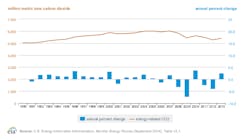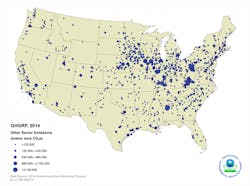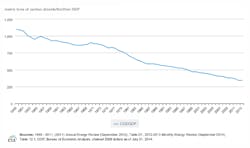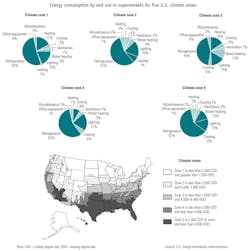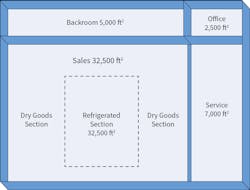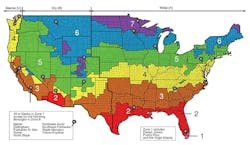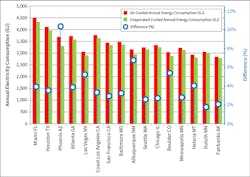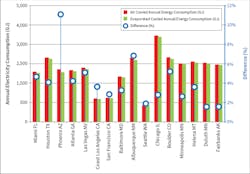Supermarket Refrigeration: Rating Compressor Cooler Systems
By RAMEZ NAGUIB, P.E., LEED AP, CEM, PMP
Clima-Tech LLC, Los Angeles CA
This paper examines the carbon footprint and environmental impact of different compressor cooling systems in commercial retail supermarket refrigeration. The research uses industry standard EnergyPlus building models to compare the environmental impact of air and evaporative cooling methods for the condensers. The energy simulation covers all climate zones across the United States. It also provides guidelines when to use one or the other depending on climates, applications and costs. Finally, the article addresses the role of natural refrigerants like CO2 and ammonia, and water-loop systems for self-contained propane cases along with the role of adiabatic condensers.
Carbon Emissions: Overall Picture
In its most recent annual report, the U.S. Environmental Protection Agency (EPA) noted that U.S. greenhouse gas emissions went up by 2% [1]. Figure 1 illustrates the changes in carbon dioxide emissions over the past few decades while Figure 2 illustrates the contributions of each sector of the economy to such emissions.
Figure 1. U.S. Energy-Related Carbon Dioxide Emissions, 1990-2013. [2]
Figure 2. Energy-related Carbon Dioxide by End-use Sectors, 1990-2013. [3]
Figure 3 illustrates the distribution of the greenhouse gas emissions from commercial sectors (excluding power plants, O&G, mining, P&P and waste) across the continental United States.
The good news though is that the carbon emissions per GDP has been steadily declining over the same period indicating better overall efficiency. Figure 4 illustrates this trend.
Figure 3. Green House Gas Emissions from Commercial Sectors (excluding power plants, O&G, mining, P&P and waste). [4]
Figure 4. Carbon Intensity of the U.S. Economy, 1949-2013. [5]
Impact of Supermarket Cooling Systems
Refrigeration systems in commercial supermarkets are among the biggest consumers of energy in such buildings, hence their impact on greenhouse gas emissions is the highest. In a typical U.S. grocery store, refrigeration and lighting represent between 44% and 77% of total use depending on climate, making these systems the best targets for energy savings. Figure 5 illustrates the energy consumption profile by end use in typical supermarkets.
Figure 5. Energy Consumption by End Use in Supermarkets. [6]
The Analytical Energy Model
This study analyzed two different compressor rack cooling options: an air-cooled option and an evaporative-cooled option.
The energy model used in all the simulations was the 45,000 ft2 (4,181 m2) Supermarket model from the DOE Commercial Building Benchmark Models as developed by the U.S. Department of Energy (DOE), Lawrence Berkeley National Laboratory (LBNL), Pacific Northwest National Laboratory (PNNL), and the National Renewable Energy Laboratory (NREL) under the Net-Zero Energy Commercial Building Initiative. [7] Figure 6 and Figure 7 illustrate the supermarket model building used in the energy simulations.
Figure 6. Rendering of the Supermarket Model Building Exterior. [8]
Figure 7. Rendering of the Supermarket Model Building Interior. [9]
All energy simulations were done using the latest publicly available version of EnergyPlus (8.3.0), as also developed by DOE and NREL.
The 16 different climate zones modeled covered the entire spectrum of U.S. climate conditions. The climate zones modeled across the United States are shown in Figure 8.
Figure 8. DOE climate zones and representative cities. [10]
The data from the energy simulation model was captured for a full 365 days a year, 24 hours a day and at 10-minute intervals each hour, in 16 climate zones with two compressor rack cooling system options for a total of 2,803,200 data points.
Figures 8, 9 and 10 illustrate the annual electricity consumption, annual Carbon Dioxide emissions and annual water consumption of the different refrigeration systems from the simulations.
Figure 9. Annual Electricity Consumption.
Figure 10. Annual Carbon Dioxide Emissions.
So, When to Use One or the Other?
The answer to this question is not necessarily straight forward. The prudent answer here is that “it depends”. It depends on the climate zone where the installation is, the actual application, the costs associated with installing and running the application.
Though these are beyond the scope of this article, a previous analysis by the author found that the answers to these questions are not necessarily straightforward. Some of the answers out of the analysis even defied common wisdom and ongoing “best practices”.[11]
Just as in that previous article, the intention here is not to answer such questions, but to open the subject for further discussions. [12]
So this serves as a “starter”, a primer for further scrutiny and analysis. The current analysis only focused on a typical grocery store building profile. More work needs to be done to see if the same insight can be derived for other types of buildings: refrigerated distribution centers, retail applications, etc.
Here are some more ideas and suggestions for further study:
- What happens when we already have a water-cooled system and we want to add another machine? Would the impact be the same?
- Though the water-cooled systems have lower kW/ton advantage over air-cooled ones, fouled condensers can rapidly deteriorate that advantage. Detailed analysis accounting for such performance degradations should be considered;
- How does this picture change when utilizing natural refrigerants like CO2 or ammonia? What about water-loop systems for self-contained propane cases?
- Would adiabatic condensers be better for the carbon emissions but worse for the water consumption or better for both?
Conclusion
The aim of this article is not to give designers, owners or operators a direct how-to manual for their supermarkets and grocery stores refrigeration systems. The objective rather is to illustrate the environmental as well as the economic impacts of the different choices of their refrigeration systems.
The analysis of the environmental effects from the different refrigeration systems revealed the implicit tradeoffs between optimizing electricity consumption, Carbon Dioxide emissions and annual water consumption. These, as well as other aspects not addressed in this paper, should be considered when assessing the refrigeration systems in such applications.
___________________________
The author is President and CEO of Clima-Tech LLC in Los Angeles CA. He has worked on some of the largest refrigeration, central cooling and heating projects domestically and internationally. The author of several papers on various engineering, economic and management topics, he can be reached at [email protected].
___________________________
References
[1] Inventory of U.S. Greenhouse Gas Emissions and Sinks: 1990-2013. U.S. Environmental Protection Agency. April 15, 2015.
[2] U.S. Energy-Related Carbon Dioxide Emissions, 2013. October 2014. U.S. Department of Energy, Washington, DC 20585.
[3] Ibid.
[4] Ibid.
[5] Ibid.
[6] Managing Energy Costs in Grocery Stores. 2002. National Grid. E Source Companies.
[7] The Benchmark buildings are available from the U.S. Department of Energy website at http://energy.gov/eere/buildings/commercial-reference-buildings.
See also Torcellini, P. et al. (2008). DOE Commercial Building Benchmark Models. National Renewable Energy Laboratory.
[8] Clark, J. 2015. Energy-Efficient Supermarket Heating, Ventilation, and Air Conditioning in Humid Climates in the United States. National Renewable Energy Laboratory. Technical Report NREL/TP-5500-6.
[9] Ibid.
[10] Bonnema, E., et al. 2010. Large Hospital 50% Energy Savings: Technical Support Document. National Renewable Energy Laboratory. Technical Report NREL/TP-550-47867).
[11] Naguib, R. 2009. Total Cost of Ownership for Air-Cooled and Water-Cooled Chiller Systems. ASHRAE Journal. 51(4):42-48.
[12] Ibid.

